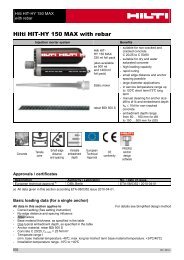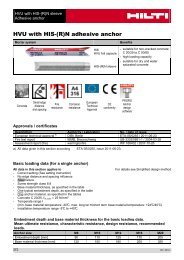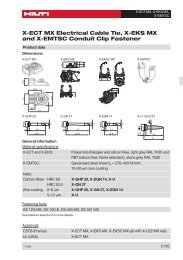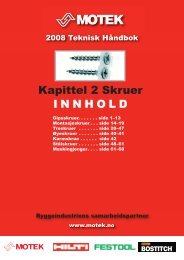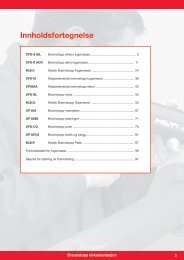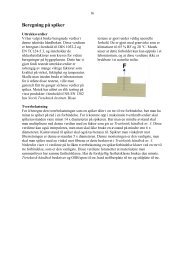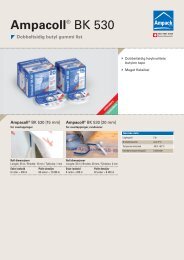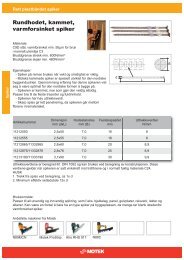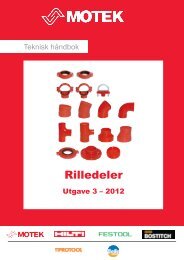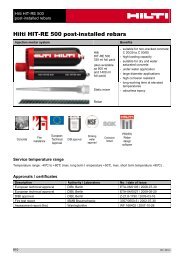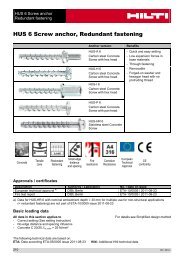Hilti HIT-HY 150 MAX post-installed rebars - coBuilder
Hilti HIT-HY 150 MAX post-installed rebars - coBuilder
Hilti HIT-HY 150 MAX post-installed rebars - coBuilder
You also want an ePaper? Increase the reach of your titles
YUMPU automatically turns print PDFs into web optimized ePapers that Google loves.
<strong>Hilti</strong> <strong>HIT</strong>-<strong>HY</strong> <strong>150</strong> <strong>MAX</strong><br />
<strong>post</strong>-<strong>installed</strong> <strong>rebars</strong><br />
<strong>Hilti</strong> <strong>HIT</strong>-<strong>HY</strong> <strong>150</strong> <strong>MAX</strong> <strong>post</strong>-<strong>installed</strong> <strong>rebars</strong><br />
Injection mortar system<br />
Benefits<br />
<strong>Hilti</strong><br />
<strong>HIT</strong>-<strong>HY</strong> <strong>150</strong><br />
<strong>MAX</strong><br />
330 ml foil pack<br />
(also available<br />
as 500 ml<br />
and 1400 ml<br />
foil pack)<br />
Static mixer<br />
Rebar<br />
- suitable for concrete C 12/15 to<br />
C 50/60<br />
- high loading capacity and fast<br />
cure<br />
- suitable for dry and water<br />
saturated concrete<br />
- for rebar diameters up to 25 mm<br />
- non corrosive to rebar elements<br />
- good load capacity at elevated<br />
temperatures<br />
- hybrid chemistry<br />
- multiplication factor for minimum<br />
anchoring and splice length 1.0<br />
- suitable for embedment length till<br />
2000 mm<br />
- suitable for applications down to -<br />
10 °C<br />
Concrete<br />
Fire<br />
resistance<br />
European<br />
Technical<br />
Approval<br />
CE<br />
conformity<br />
Drinking<br />
water<br />
appoved<br />
Corossion<br />
tested<br />
PROFIS<br />
Rebar<br />
design<br />
software<br />
Service temperature range<br />
Temperature range: -40°C to +80°C (max. long term t emperature +50°C, max. short term temperature +80°C) .<br />
Approvals / certificates<br />
Description Authority / Laboratory No. / date of issue<br />
European technical approval a) CSTB, France ETA-08/0202 / 2008-07-24<br />
European technical approval a) CSTB, France ETA-08/0352 / 2009-12-18<br />
National Approval DIBt, Berlin DIBt Z-21.8-1882 / 2010-08-13<br />
Fire test report DIBt, Berlin DIBt Z-21.8-1882 / 2010-08-13<br />
Assessment report (fire) Warringtonfire WF 166402 / 2007-10-26<br />
a)<br />
All data given in this section according ETA-08/0202, issue 2008-07-24.<br />
838<br />
09 / 2012
<strong>Hilti</strong> <strong>HIT</strong>-<strong>HY</strong> <strong>150</strong> <strong>MAX</strong><br />
<strong>post</strong>-<strong>installed</strong> <strong>rebars</strong><br />
Materials<br />
Reinforcmenent bars according to EC2 Annex C Table C.1 and C.2N.<br />
Properties of reinforcement<br />
Product form<br />
Bars and de-coiled rods<br />
Class B C<br />
Characteristic yield strength f yk or f 0,2k (MPa) 400 to 600<br />
Minimum value of k = (f t /f y ) k ≥ 1,08<br />
≥ 1,15<br />
< 1,35<br />
Characteristic strain at maximum force, ε uk (%) ≥ 5,0 ≥ 7,5<br />
Bendability<br />
Maximum deviation from<br />
nominal mass<br />
(individual bar) (%)<br />
Bond:<br />
Minimum relative rib area,<br />
f R,min<br />
Nominal bar size (mm)<br />
≤ 8<br />
> 8<br />
Nominal bar size (mm)<br />
8 to 12<br />
> 12<br />
Bend / Rebend test<br />
± 6,0<br />
± 4,5<br />
0,040<br />
0,056<br />
Setting details<br />
For detailed information on installation see instruction for use given with the package of the product.<br />
Working time, Curing time<br />
Temperature<br />
of the base material T BM<br />
Working time<br />
t gel<br />
Curing time<br />
t cure<br />
-10 °C ≤ T BM < -5 °C 180 min 12 h<br />
-5 °C ≤ T BM < -0 °C 90 min 9 h<br />
0 °C ≤ T BM < 5 °C 45 min 4,5 h<br />
5 °C ≤ T BM < 10 °C 20 min 2 h<br />
10 °C ≤ T BM < 15 °C 7 min 50 min<br />
15 °C ≤ T BM < 20 °C 6 min 40 min<br />
20 °C ≤ T BM < 25 °C 5 min 30 min<br />
25 °C ≤ T BM < 30 °C 3 min 30 min<br />
30 °C ≤ T BM ≤ 40 °C 2 min 30 min<br />
09 / 2012 839
<strong>Hilti</strong> <strong>HIT</strong>-<strong>HY</strong> <strong>150</strong> <strong>MAX</strong><br />
<strong>post</strong>-<strong>installed</strong> <strong>rebars</strong><br />
Dry and water-saturated concrete, hammer drilling<br />
a)<br />
a) Note: Manual cleaning for element sizes d ≤ 16mm and embedment depth h ef ≤ 10 d only!<br />
840<br />
09 / 2012
<strong>Hilti</strong> <strong>HIT</strong>-<strong>HY</strong> <strong>150</strong> <strong>MAX</strong><br />
<strong>post</strong>-<strong>installed</strong> <strong>rebars</strong><br />
Fitness for use<br />
Creep behaviour<br />
Creep tests have been conducted in accordance with ETAG guideline 001 part 5 and TR 023 in the following<br />
conditions: in dry environnement at 50 °C during 90 days.<br />
These tests show an excellent behaviour of the <strong>post</strong>-<strong>installed</strong> connection made with <strong>HIT</strong>-<strong>HY</strong> <strong>150</strong> <strong>MAX</strong>: low<br />
displacements with long term stability, failure load after exposure above reference load.<br />
Water behaviour<br />
Water: <strong>HIT</strong>-<strong>HY</strong> <strong>150</strong> <strong>MAX</strong> is water tight and water resistant, without any toxicity risk for the environnement.<br />
Drinking water: <strong>HIT</strong>-<strong>HY</strong> <strong>150</strong> <strong>MAX</strong> is «NSF» certified, in accordance with NSF/ANSI St 61 «Drinking Water<br />
System Components - Health Effects». Tests are done at 60 °C, which corresponds to domestic hot water. The<br />
use of <strong>HIT</strong>-<strong>HY</strong> <strong>150</strong> <strong>MAX</strong> is possible for water tanks.<br />
Resistance to chemical substances<br />
Chemical substance Comment Resistance<br />
Sulphuric acid 23°C +<br />
Under sea water 23°C +<br />
Under water 23°C +<br />
Alkaline medium pH = 13,2, 23°C +<br />
Drilling diameters<br />
Rebar (mm)<br />
Drill bit diameters d 0 [mm]<br />
Hammer drill (HD)<br />
Compressed air drill (CA)<br />
8 12 (10 a) ) -<br />
10 14 (12 a) ) -<br />
12 16 (14 a) ) 17<br />
14 18 17<br />
16 20 20<br />
18 22 22<br />
20 25 26<br />
22 28 28<br />
24 32 32<br />
25 32 32<br />
a) Max. installation length I = 250 mm.<br />
09 / 2012 841
<strong>Hilti</strong> <strong>HIT</strong>-<strong>HY</strong> <strong>150</strong> <strong>MAX</strong><br />
<strong>post</strong>-<strong>installed</strong> <strong>rebars</strong><br />
Basic design data for rebar design according to rebar ETA<br />
Bond strength in N/mm² according to ETA 08/0202 for good bond conditions<br />
for all drilling methods<br />
Rebar (mm)<br />
Concrete class<br />
C12/15 C16/20 C20/25 C25/30 C30/37 C35/45 C40/50 C45/55 C50/60<br />
8 - 24 1,6 2,0 2,3 2,7 3,0 3,4 3,4 3,4 3,7<br />
25 1,6 2,0 2,3 2,7 3,0 3,4 3,7 3,7 3,7<br />
Pullout design bond strength for Hit Rebar design<br />
Design bond strength in N/mm² according to ETA 08/0352 (values in table are<br />
design values, fbd,po = τRk/γMp<br />
Hammer or compressed air drilling. Uncracked concrete C20/25.<br />
temperature<br />
Bar diameter<br />
range 8 10 12 14 16 20 22 24 25<br />
I: 40°C/24°C 5,3 6,3 5,3<br />
II: 80°C/50°C 4,4 5,3 4,4<br />
III: 120°C/72°C 2,8 3,3 2,8<br />
Hammer or compressed air drilling. Cracked concrete C20/25.<br />
temperature<br />
Bar diameter<br />
range 8 10 12 14 16 20 22 24 25<br />
I: 40°C/24°C - 3,7 4,0 3,3<br />
II: 80°C/50°C - 3,0 3,3 3,7 4,0 3,3<br />
III: 120°C/72°C - 2,0 2,3 2,2<br />
Increasing factor in non-cracked concrete: f B,p =(f cck /25) 0,1 (f cck : characteristic compressive strength on cube)<br />
Additional <strong>Hilti</strong> Technical Data<br />
Reduction factor for splitting with large concrete cover: δ = 0,306<br />
842<br />
09 / 2012
<strong>Hilti</strong> <strong>HIT</strong>-<strong>HY</strong> <strong>150</strong> <strong>MAX</strong><br />
<strong>post</strong>-<strong>installed</strong> <strong>rebars</strong><br />
Fire Resistance according to DIBt Z-21.8-1882<br />
a) fire situation “anchorage”<br />
l inst<br />
Maximum force in rebar in conjunction with <strong>Hilti</strong> <strong>HIT</strong>-<strong>HY</strong> <strong>150</strong> Max as a function of embedment depth for the<br />
fire resistance classes F30 to F240 (yield strength f yk = 500 N/mm²) according EC2 a) .<br />
Bar ∅ Drill hole ∅ Max. F s,T l inst R30 R60 R90 R120 R180<br />
[mm] [mm] [kN] [mm] [kN] [kN] [kN] [kN] [kN]<br />
80 3,0 0,7 0,2 0 0<br />
120 7,0 2,2 1,3 0,7 0,2<br />
170 16,2 10,2 9,2 4,0 1,7<br />
8 12 16,2 210 16,2 16,2 11,0 7,5<br />
230 14,5 10,9<br />
250 16,2 14,4<br />
300 16,2<br />
100 6,1 2,0 1,0 0,4 0<br />
<strong>150</strong> 19,3 9,3 7,1 2,2 1,0<br />
190 25,3 18,0 15,9 9,3 4,9<br />
10 14 25,3 230 25,3 24,7 18,1 13,7<br />
260 25,3 24,7 20,3<br />
280 25,3 24,7<br />
320 25,3<br />
120 15,3 6,0 1,9 1,1 0,3<br />
180 31,0 19,0 17,8 8,5 7,0<br />
220 36,4 29,6 27,0 19,1 13,8<br />
12 16 36,4 260 36,4 36,4 29,7 24,4<br />
280 35,0 29,6<br />
300 36,4 34,9<br />
340 36,4<br />
140 24,0 9,9 6,9 2,6 1,0<br />
210 45,0 31,4 28,5 25,7 13,0<br />
14 18 49,6<br />
240 49,6 40,6 37,7 32,8 22,3<br />
280 49,6 49,6 40,7 34,6<br />
300 44,7 40,7<br />
330 49,6 49,6<br />
160 34,5 18,4 14,9 4,4 2,3<br />
240 62,6 46,4 43,0 37,7 25,5<br />
16 20 64,8<br />
260 64,8 53,5 50,0 44,7 32,5<br />
300 64,8 57,0 51,7 46,6<br />
330 64,8 61,3 57,2<br />
360 64,8 64,8<br />
200 60,7 40,0 36,3 29,3 14,2<br />
250 78,3 62,5 58,3 51,3 36,3<br />
310 101,2 88,9 84,6 77,6 62,6<br />
20 25 101,2 350 101,2 101,2 94,2 80,2<br />
370 101,2 83,5<br />
390 97,8<br />
430 101,2<br />
09 / 2012 843
<strong>Hilti</strong> <strong>HIT</strong>-<strong>HY</strong> <strong>150</strong> <strong>MAX</strong><br />
<strong>post</strong>-<strong>installed</strong> <strong>rebars</strong><br />
Bar ∅ Drill hole ∅ Max. F s,T l inst R30 R60 R90 R120 R180<br />
[mm] [mm] [kN] [mm] [kN] [kN] [kN] [kN] [kN]<br />
250 97,9 78,1 72,9 64,7 45,3<br />
280 126,5 94,6 89,4 81,2 61,8<br />
370 158,1 144,0 127,9 119,7 111,2<br />
25 32 158,1 410 158,1 <strong>150</strong>,0 141,8 123,2<br />
430 158,1 <strong>150</strong>,0 144,2<br />
450 158,1 155,2<br />
500 158,1<br />
a)<br />
For <strong>Hilti</strong> <strong>HIT</strong>-<strong>HY</strong> <strong>150</strong> <strong>MAX</strong> rebar only the standard acc. EC2 is available (Data also in Warringtonfire report<br />
WF 166402 or/and IBMB Braunschweig report No 3884/8246-CM.<br />
844<br />
09 / 2012
<strong>Hilti</strong> <strong>HIT</strong>-<strong>HY</strong> <strong>150</strong> <strong>MAX</strong><br />
<strong>post</strong>-<strong>installed</strong> <strong>rebars</strong><br />
b) fire situation “anchorage”<br />
Max. bond stress, τ T , depending on actual clear concrete cover for classifying the fire resistance.<br />
It must be verified that the actual force in the bar during a fire, F s,T , can be taken up by the bar connection of the<br />
selected length, l inst . Note: Cold design for ULS is mandatory.<br />
F s, T ≤ (l inst – c f )⋅ ∅ ⋅ π ⋅ τ T where: (l inst – c f ) ≥ l s ;<br />
l s<br />
∅<br />
= lap length<br />
= nominal diameter of bar<br />
l inst – c f = selected overlap joint length; this must be at least l s ,<br />
but may not be assumed to be more than 80 ∅<br />
τ T<br />
= bond stress when exposed to fire<br />
Critical temperature-dependent bond stress, τ c , concerning “overlap joint” for <strong>Hilti</strong> <strong>HIT</strong>-<strong>HY</strong> <strong>150</strong> <strong>MAX</strong><br />
injection adhesive in relation to fire resistance class and required minimum concrete coverage c.<br />
Clear concrete cover c<br />
Max. bond stress, τ c [N/mm²]<br />
[mm] R30 R60 R90 R120 R180<br />
30 0,6 0,3<br />
35 0,7 0,3<br />
0<br />
40 0,9 0,4 0,2<br />
0<br />
45 1,0 0,4 0,2<br />
50 1,2 0,5 0,3<br />
0<br />
55 1,5 0,6 0,3 0,2<br />
60 1,8 0,8 0,4 0,3<br />
65 2,2 0,9 0,5 0,3<br />
70 2,7 1,0 0,5 0,3<br />
75 3,4 1,2 0,6 0,4 0,2<br />
80<br />
1,5 0,7 0,5 0,3<br />
85 1,7 0,8 0,5 0,3<br />
90 2,0 1,0 0,6 0,3<br />
95 2,2 1,1 0,7 0,4<br />
100 2,4 1,3 0,8 0,4<br />
105 2,7 1,5 0,9 0,5<br />
110 3,0 1,7 1,1 0,5<br />
115 3,4 2,0 1,2 0,6<br />
120<br />
2,2 1,4 0,6<br />
125 2,5 1,6 0,7<br />
130 2,8 1,9 0,8<br />
135 3,0 2,1 0,9<br />
140 3,7<br />
3,4 2,3 1,0<br />
145<br />
2,6 1,1<br />
<strong>150</strong> 2,9 1,2<br />
155 3,1 1,3<br />
160 3,7<br />
3,4 1,4<br />
165 3,5 1,5<br />
170<br />
1,6<br />
3,7<br />
175 1,7<br />
180 1,8<br />
185 3,7<br />
1,9<br />
190 2,1<br />
195 2,2<br />
200 2,3<br />
09 / 2012 845
<strong>Hilti</strong> <strong>HIT</strong>-<strong>HY</strong> <strong>150</strong> <strong>MAX</strong><br />
<strong>post</strong>-<strong>installed</strong> <strong>rebars</strong><br />
Minimum anchorage length<br />
According to ETA-08/0202, the multiplication factor for minimum anchorage length is 1,0 for all approved drilling<br />
methods.<br />
Minimum anchorage and lap lengths for C20/25; maximum hole lengths<br />
Diameter d s<br />
[mm]<br />
Rebar<br />
f y,k<br />
[N/mm²]<br />
l b,min *<br />
[mm]<br />
Hammer drilling,<br />
Compressed air drilling<br />
l 0,min *<br />
[mm]<br />
l max<br />
[mm]<br />
8 500 113 200 1000<br />
10 500 142 200 1000<br />
12 500 170 200 1000<br />
14 500 198 210 1000<br />
16 500 227 240 <strong>150</strong>0<br />
18 500 255 270 2000<br />
20 500 284 300 2000<br />
22 500 312 330 2000<br />
24 500 340 360 2000<br />
25 500 354 375 2000<br />
* l b,min (8.6) and l 0,min (8.11) are calculated for good bond conditions with maximum utilisation of rebar yield<br />
strength f yk = 500 N/mm² and α 6 = 1,0<br />
846<br />
09 / 2012
<strong>Hilti</strong> <strong>HIT</strong>-<strong>HY</strong> <strong>150</strong> <strong>MAX</strong><br />
<strong>post</strong>-<strong>installed</strong> <strong>rebars</strong><br />
09 / 2012 847




